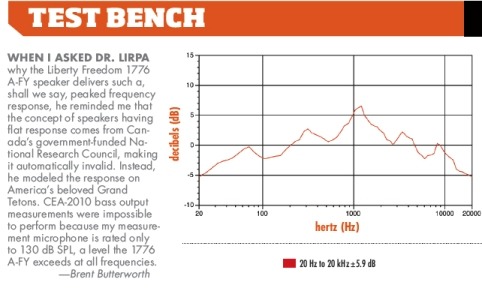Test Report: Lirpa Labs Liberty Freedom 1776 A-FY Tower Speakers Page 4


Frequency response (at 100 yards):
20 Hz to 20 kHz ±5.9 dB
Sensitivity (SPL at 1 meter with 2.8 volts of pink-noise input):
130 dB (our measurement limit)
Impedance (minimum/nominal):
1.776/8 ohms
Bass output (CEA-2010 standard):
Ultra-low bass (20-31.5 Hz): 130.0 dB (our measurement limit)
Low bass (40-63 Hz): 130.0 dB (our measurement limit)
Measuring the Lirpa Labs Liberty Freedom 1776 A-FY proved to be one of the greatest challenges of my career, partly because in so many ways it exceeds the measured performance of any other speaker ever made (or even imagined), and partly because in other ways its measured performance is outclassed by that of a Motel 6 clock radio. That is, of course, if the speaker is judged by, as Dr. Lirpa put it, “the standards to which other manufacturers so blindly adhere.”
I normally measure speakers at a distance of 2 meters to ensure that full effects of cabinet diffraction and front-panel reflections are included. However, at this distance the sound waves produced by the 1776 A-FY were powerful enough to knock down my microphone stand. Even when I moved the microphone to a distance of 100 meters, the levels proved overwhelming. However, when I moved the mic to a distance of 100 yards, everything suddenly worked just fine. Close-miking the woofer was impractical because the woofer’s high output levels made it impossible to get anywhere near it, even when the speaker cables were disconnected.
It is obvious at a glance that the 1776 A-FY’s frequency response is idiosyncratic, to say the least. When I asked Dr. Lirpa why he chose such a radically different response, he berated me for buying into the “ridiculous” industry standards formulated at Canada’s National Research Council. (“You might as well call up Fidel Castro and ask him how he thinks speakers should perform,” Dr. Lirpa said.) He decided instead to model the 1776 A-FY’s response on the profile of the United States’ most beautiful natural attraction, the Grand Tetons. I pointed out that the Grand Tetons were named by French explorers, and he replied, “Yeah, but do you know what Grand Tetons means in French? That’s as American a concept as there ever was.”
Anechoic sensitivity (averaged output at 1 meter from 200 Hz to 10 kHz) was unmeasureable because my measurement microphone is rated for use up to 130 dB, and the 1776 A-FY exceeds this level at all frequencies no matter what the input signal, even when driven via the headphone jack of my Motorola Droid Pro cellphone. Impedance measured dead flat at 8 ohms across the audio band, except for a surprising dip down to 1.776 ohms at 17.76 kHz. (I assume Dr. Lirpa chose this curve to keep impedance at this hallowed frequency down to a bare minimum.) Thus, any amplifier can drive this speaker to loud levels. In fact, the noise floor of any amplifier is sufficient to drive this speaker to levels louder than any human can tolerate. I didn’t dare attempt to measure the speaker with any of its rear-panel switches activated.
CEA-2010 bass output measurements proved impossible to perform because of my microphone’s 130 dB SPL limit and the Liberty Freedom 1776 A-FY’s inability to produce a lower level than this with any input signal. Thus, I have no way of expressing the speaker’s bass capabilities. However, it is worth noting that the Zakouma National Park in the African nation of Chad experienced an unprecedentedly destructive elephant stampede at the exact time I attempted to run these measurements. —Brent Butterworth
- Log in or register to post comments














































